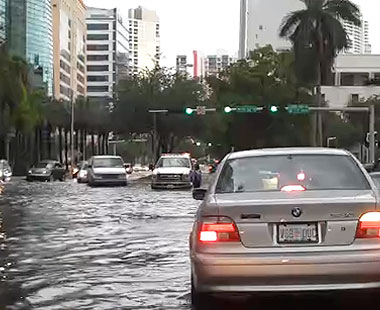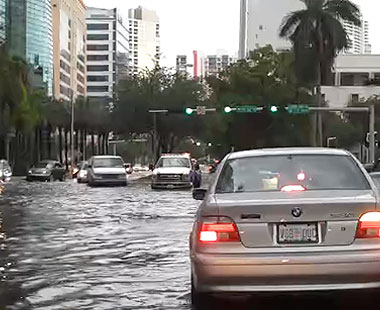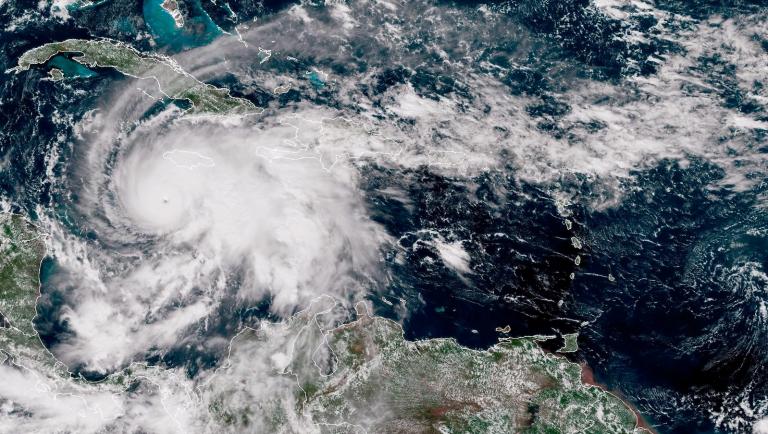 Flooding in Miami.Photo: kthreadDan Kipness, a retired fishing boat captain and a 60-year Miami Beach resident, has a video that offers a glimpse of where this coastal city is headed. In it, cars and trucks kick floodwater into the air as they drive down Miami Beach’s streets. This isn’t rainwater — the skies are at least partially sunny and blue. Instead, the waters seeped into the streets from underground storm sewers during high tide.
Flooding in Miami.Photo: kthreadDan Kipness, a retired fishing boat captain and a 60-year Miami Beach resident, has a video that offers a glimpse of where this coastal city is headed. In it, cars and trucks kick floodwater into the air as they drive down Miami Beach’s streets. This isn’t rainwater — the skies are at least partially sunny and blue. Instead, the waters seeped into the streets from underground storm sewers during high tide.
Kipness says he never saw such flooding until a decade ago, but now sees it up to twice a day during the fall, when tides are especially high. He says he’s watched the undersides of $100,000 cars get rusted away by salt water.
This happens, many experts say, because of rising sea levels attributed to the melting of ice sheets in Greenland and Antarctica. We can expect to see more of the same across South Florida in the coming years, as a warming climate accelerates the faraway melting. Researchers are just now beginning to grapple with what this will mean for the inner workings of the city.
Miami is one of the world’s most vulnerable cities to rising sea levels from climate change, according to the international Organization of Economic Cooperation and Development. Sea levels have risen nine to 12 inches here in the past century, and are expected to rise up to six more inches by 2030, 12 to 21 inches by 2060, and by three to five feet by 2100.
What will this look like? With a two-foot rise, water would cover 28 percent of South Florida and wetlands would be lost as far from the coast as Homestead, about a 125-mile drive from Key West. Miami would become a barrier island, Hal Wanless, chair of the University of Miami’s geology department, told members of the Society of Environmental Journalists, which held its annual conference here last week.
With a four-foot rise, 48 percent of the land in South Florida would be soaked, the Everglades would become an estuary, and two proposed nuclear plants at Turkey Point along the eastern coast would be underwater. At five feet of rise, storm surges would flow in all directions. At six feet, 56 percent of the land would be gone and 73 percent of what’s left would be less than two feet above sea level.
“In other words, you wouldn’t want to live in it,” says Wanless, who co-chairs a science committee for the Miami-Dade County climate change task force.
But while those scenarios have been well studied, another has barely peeped onto the experts’ radar screen — the potential for large-scale gentrification of lower-income, minority areas on higher ground by affluent, coastal residents who would buy and fix up aging homes there, pushing existing residents out.
Gentrification is already spreading in Miami’s urban core with an increasing array of high-rise condo projects along Biscayne Boulevard north of downtown. As sea levels rise, development pressure is bound to push further, to the neighborhoods along the coastal ridge, standing 15 to 20 feet above sea level.
These ridge areas were settled as long ago as the 1920s and ’30s, when blacks came to the Overtown area. After much of the area was drained to allow for development, Asians, Cubans, and Haitians settled on the ridge land.
“It’s where they built the railroad — nobody wanted to live along the railroad,” says Kipness, the retired fishing captain. “It’s the last place to flood.”
In Little Haiti along Northeast 2nd Ave., starting a bit north of downtown, a large Haitian community has found a niche and opened stores with French and Creole names such as Jenin’s Grocery, Pinan Bauta restaurant, and Libreri Mapou bookstore. A sign offers “unlimited calls to Haiti” for $39.99 a month.
Gentrification is already reshaping this and other inland areas, says Hugh Gladwin, an associate sociology-anthropology professor at Miami’s Florida International University. “It’s creating pressure on neighborhoods that have houses on high ground.”
Gladwin, who doubles as director of Florida International’s Institute of Public Opinion, is one of the few people in the region to publicly raise this issue of sea-level-driven gentrification. “Somebody’s going to go there and it’s probably going to be somebody with money,” he says.
If tough decisions have to be made to relocate people from the coast, it will require higher densities in the urban core, said Nichole Hefty, climate change program coordinator for the Miami-Dade County government, at the Little Haiti Cultural Center. “How do you do that without immense human costs? What happens to a thriving community when you suddenly have to make these decisions?”
Gladwin predicts that if the Haitian-American community is driven from Little Haiti, they’ll just go somewhere else because a goodly number of them are “U.S. citizens, hardworking and smart. The worst problems are going to be for Hispanics, particularly Cubans, who came here more recently and who don’t speak English.”
Other cities have installed floodgates to protect from storm surges and rising tides, but Miami is not the Netherlands, where authorities can stick walls into the ground to hold back the sea, says Jayantha Obeysekera, chief modeler for the six-county South Florida Water Management District. “Our groundwater system consists of limestone — it’s very porous, it’s like Swiss cheese.”
To cope with the rising seawater that seeps in through the ground, and with flooding created by stormwater runoff, authorities have built 28 pump stations in the region. But the water district’s Obeysekera says pumps and other technological fixes won’t protect everyone from higher seas. “If the sea level rise is two or three feet, water would come around structures into low-lying areas — if you put as many pumps in as you want, it won’t protect you,” Obeysekera says.
Still, many in this city cling to the belief that technology can overcome the coming floods. Realtor Scott Diffender has lived in the Miami Beach area for nearly 20 years. He has watched high tide flooding increase and rust out more and more cars. But he doesn’t think he’ll have to leave.
“There’s billions of dollars of real estate there,” says Diffender, who runs a homeowners association on Belle Isle, a barrier island between Miami and Miami Beach. “I can’t believe they can’t protect it.”
Even if they could work, the fixes would be pricey. Pump stations and other technological fixes would cost $500 million to $1 billion over the next 70 to 100 years, raising monthly household utility bills by up to $100, according to a new report from scientists at Florida Atlantic University in Fort Lauderdale.
Still, another member of the county’s climate change task force offers a vision that is somewhat less apocalyptic than some of her colleagues’. Elizabeth Plater-Zyberk, dean of the University of Miami’s architecture school, agrees with Gladwin and others that some gentrification is a likely outcome of rising sea levels, but says that the local government could find ways to do “triage,” allowing some neighborhoods to go underwater, while saving others.
“We can make decisions on what to protect,” says Plater-Zyberk, who, along with her architect partner and husband Andres Duany, is one of the country’s leading thinkers on new urbanism and sustainability. “A shopping center in the lowlands is a box full of air, and we may not want to protect it. A downtown area in the lowlands, we may want to protect.”
And some areas will be able to adapt, Plater-Zyberk says, just as some parts of Venice have been able to adapt to that city’s rising canal water levels. “We are ahead of Detroit. We have the opportunity to manage change over time.”




